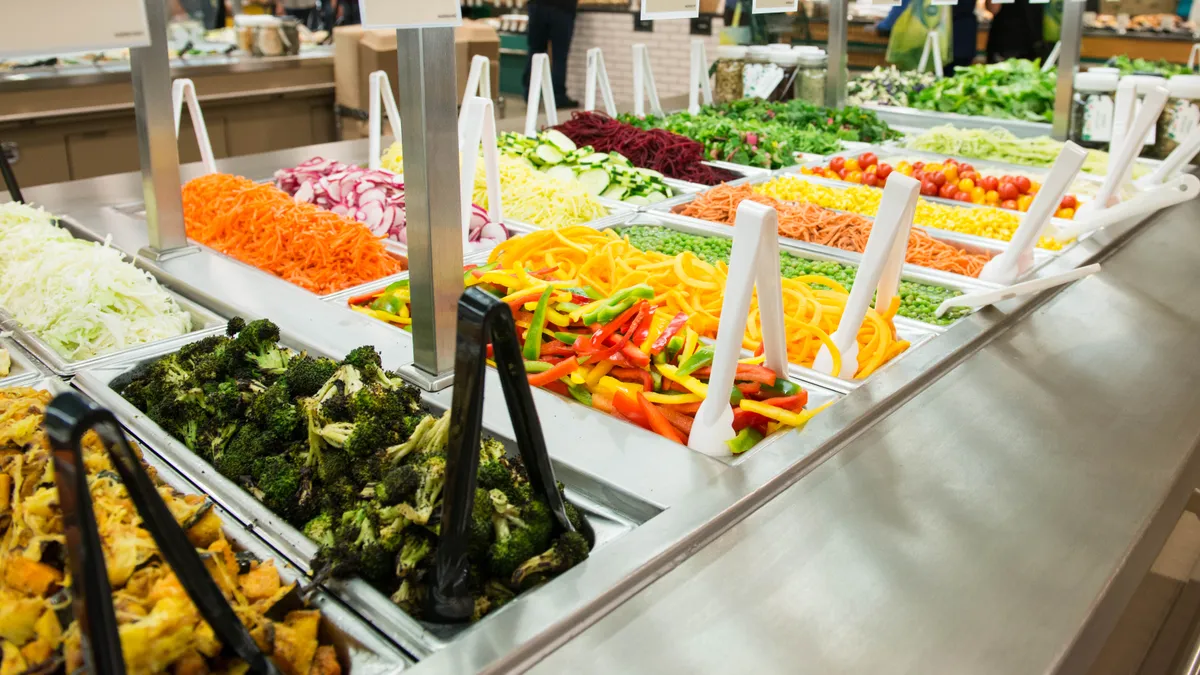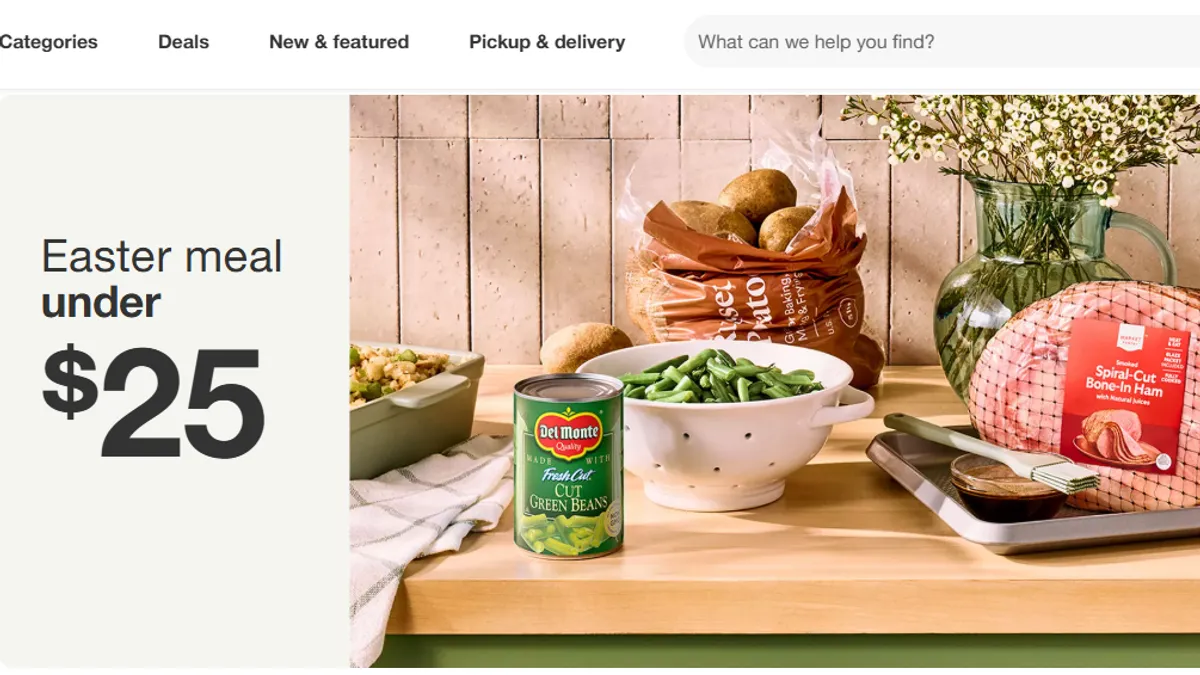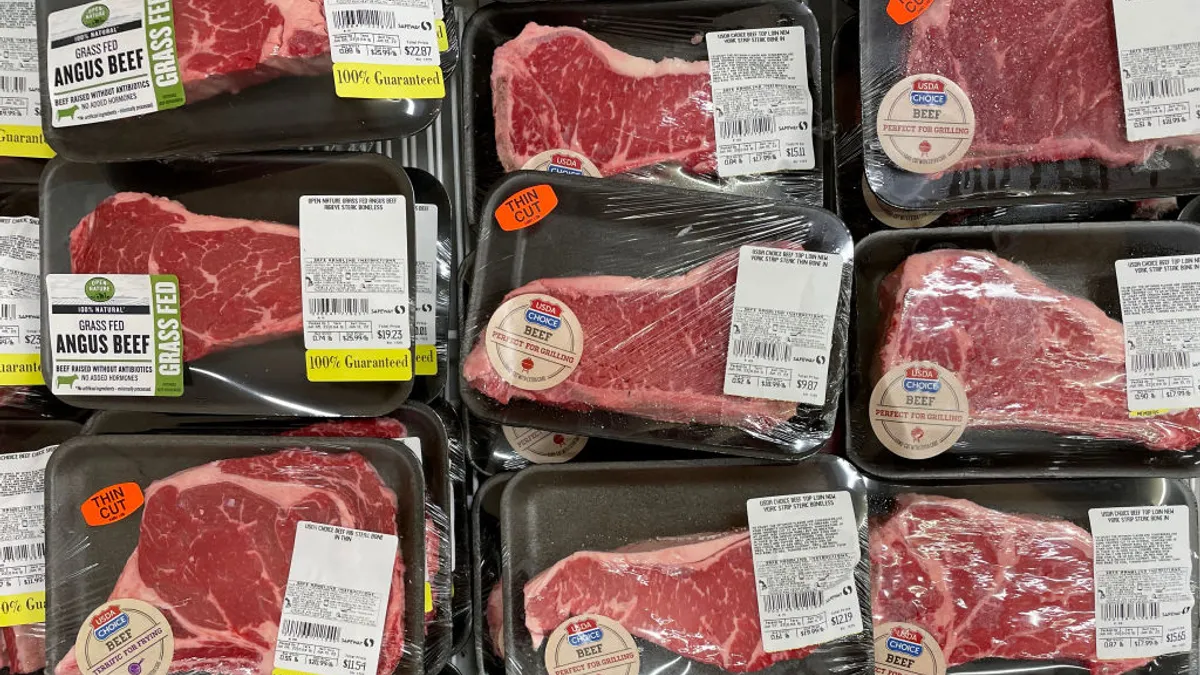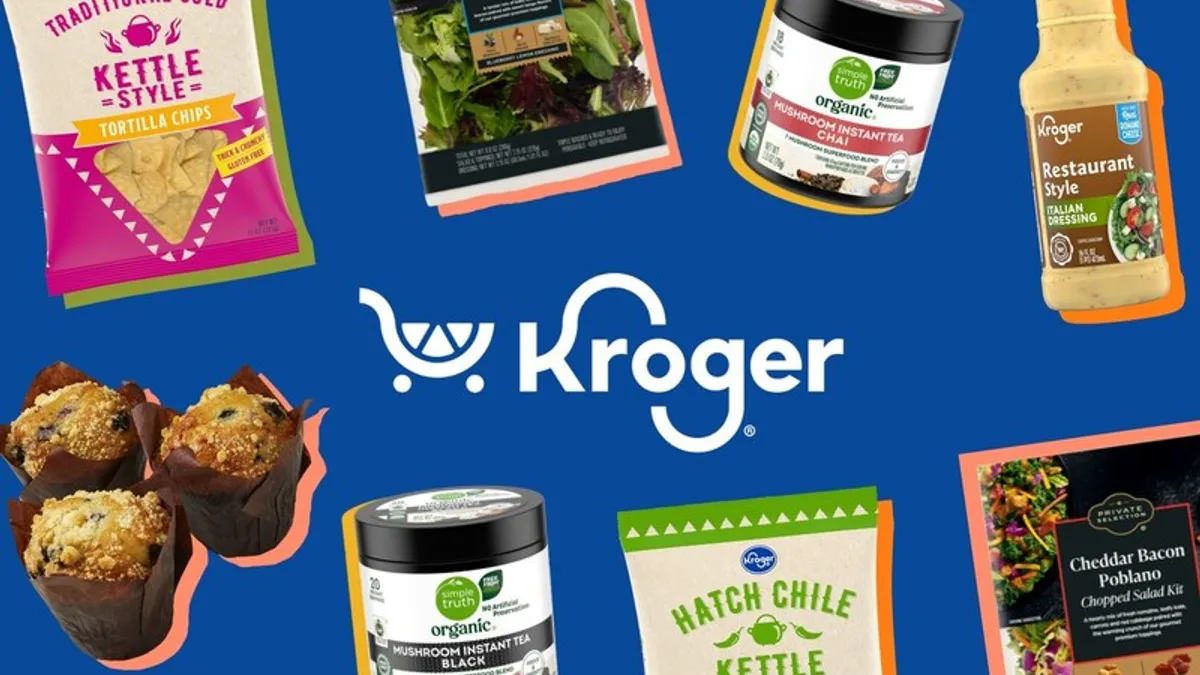Forced by the pandemic to beat a hasty retreat from the self-service prepared food operations they spent years developing, grocers have started examining strategies to return the facilities to profitable use.
But as they look for ways to put dormant salad bars, hot food counters and other self-service stations back into selling mode, retailers face an array of logistical and marketing challenges that will demand creativity and tenacity to overcome, according to retailers, consultants and other experts interviewed by Grocery Dive.
"Grocers have put in anywhere from 70 to 200 feet of self-service space in their stores, and now they’re all asking, 'What do we do? What are we going to do with all this space?'" Steve Petusevsky, a foodservice consultant and former director of culinary innovation at Whole Foods Market, told Grocery Dive.
In contrast with booming sales across center store, fresh produce and proteins, prepared food sales are down 30% to 40% since the COVID-19 pandemic struck, Petusevsky said. Sales have been improving as shoppers venture back into stores. Deli prepared food sales were down 47% in mid-April, according to IRI, but climbed to a 27% decline during the last week of May.
Grocers now face a difficult choice between trying to reopen those once-lucrative facilities or converting them to other uses, possibly for good. Some, like PCC Community Markets in Seattle, are still waiting for guidance from local health officials and don't know when they'll be able to reopen their self-service stations — or what exactly that will look like.
In the meantime, the specialty chain of 14 stores has lined its salad bar and hot bar counters with packaged meals portioned for two and four people.
"On any given day pre-COVID, we’d have as many as 16 different unique items on our hot bar. Now, we might have six, and it's all packaged," Tracy Marik, PCC's senior deli merchandiser, told Grocery Dive.
In the Midwest, Balls Food Stores, which runs 27 stores in Kansas and Missouri under banners including Hen House, Price Chopper, Sun Fresh and PayLess, reopened salad bars at six of its supermarkets on Monday, but with restrictions, said Mike Tilden, director of deli and bakery for the grocer.
Courtesy of Balls Food Stores
At each location, a store employee continuously oversees and cleans the salad bar when it is open, and customers are required to use hand sanitizer and wear gloves in order to help themselves, Tilden said. The employee provides customers with serving utensils, which are replaced hourly. The bars have shorter hours than before the pandemic as a result of the modifications, he added.
Balls Food Stores hopes to restart self-service operations at more of its stores as conditions allow, Tilden said.
"We want to make things as normal as we can, with cases they’re used to seeing and shopping from," he told Grocery Dive. "I think we’ve done the right things to protect our customers and our teammates."
Self-service, full-service or no service?
Grocers have lately been so busy keeping their shelves stocked, their stores staffed and their e-commerce operations running that determining the fate of their self-service stations hasn't been a top priority. Now that restaurants are reopening and consumers are visiting stores more often, grocers know they need to take the next step with their meal stations, sources said.
"I don’t know how much longer they are going to be able to wait and be double-digits down in their [foodservice] businesses," Francie Dannemiller Jenks, a business development manager for Hussmann, which supplies food retailers with service bar equipment.
Demand for prepackaged salads and other ready-to-eat foods, along with meals kits, is strong, making these items a natural fit to merchandise in and around self-service stations, Jenks said.
Hussmann has been in conversations with grocers about ways to temporarily retrofit their salad bars and other equipment in order to present prepackaged foods so customers can see them from a distance. Even just raising items up and holding them at an outward-facing angle can make a significant difference, said Ryan Petrick, another business development manager for Hussmann.
But many salad stations and hot bars have been sitting unused in prominent locations, creating a challenge for retailers hoping to bring them back to life. Retailers "have been training people for the past four months that there’s nothing in the bar, so they don’t have a compelling reason to go over there," Petrick said.
The problem is compounded because salad bars generally have large surface areas that require repeated cleaning. The stations can also put off shoppers afraid of contracting COVID-19 by unwittingly touching something, Petrick said.
Petusevsky said he thinks the most practical use for salad bars right now is as cases for packaged foods. “It’s really a necessity right now until [grocers] figure this out," he said. "It’s a short-term solution, but the short-term is going to be a lot longer than we think it will be.”
Packaged comfort food like macaroni and cheese, lasagna and slices of cake seem to be especially popular right now, Petusevsky said. And many retailers are, like PCC, packaging up multi-serve meals that appeal to shoppers who are eating more at home with their families.
"Customer visits are down, and if you think about how that translates, it means shoppers are doing more stock-up shopping and are less interested in the single-serve items," Marik said.
“This is an extremely multifaceted and difficult puzzle, and is not driven by the retailer. It's driven by the consumer and where their confidence lies, and that’s what makes it hard.”
Anne-Marie Roerink
President, 210 Analytics
A growing number of retailers aren't content with using their service bars as display cases, however, and have turned them into full-service stations. Publix has reopened its salad bars with employees dishing out ingredients, while Wegmans has moved hummus and olives behind a service counter, CNBC reported.
Shifting to full-service may require equipment upgrades. Hussmann has designed sliding doors that can be installed on existing equipment so it can be used by employees to serve food or for self-service, said Jenks. Petusevsky said he's seeing retailers alter the sneeze guards on their self-service bars and add plexiglass barriers that allow employees to serve food cafeteria-style to shoppers.
Regaining momentum in foodservice is vitally important because the industry looks to that department as a differentiator, said Anne-Marie Roerink, president of 210 Analytics, a research firm that specializes in the food-retailing industry.
Now, with shoppers more concerned with getting in and out of stores as fast as possible, and many consumers turning to options like delivery and curbside pickup that keep them out of stores altogether, retailers are having to confront problems that are not entirely in their hands to solve, according to Roerink. Even if retailers are legally able to bring back their salad bars and hot bars, there's no guarantee customers will feel safe visiting the department.
"This is an extremely multifaceted and difficult puzzle, and is not driven by the retailer," Roerink said. "It’s driven by the consumer and where their confidence lies, and that’s what makes it hard."
Will shoppers come back to self-service?
Some grocers have decided they can't wait any longer, and are determined to bring back at least a portion of their self-service experience. In Houston, a local television station recently reported on a Kroger store that reopened its salad bar in violation of health department guidelines. The company told the station it's beginning to test reopening salad bars, while a county health inspector said grocers can only reopen stations where "trained food handlers" are dishing out food.
Local regulations are proving equally illuminating and frustrating for other retailers. In King and Snohomish counties in Washington state, where PCC’s stores are located, health department officials have advised the company that workers will have to carefully "monitor" self-service stations, but so far have not rolled out detailed reopening guidelines, Marik said.
"That’s one of the terms we’ve heard where we’re like, ‘okay what does that really mean?’ Does that mean somebody has eyes on it? Does that mean somebody is posted at that station?" he said. "We’re unclear, and I think they are too. We're all working through this for the first time."
Marik said he relies on local health officials along with other retailers, trade groups and the National Cooperative Grocers Association for guidance and to share best practices.
"At the end of the day if there’s any safety concern at all, [self-service] won’t come back," he said.
Tilden of Balls Food Stores said he's confident now is the right time to reintroduce self-service, but emphasized that the company has made complying with health department regulations paramount. That process is complicated by the fact that requirements vary by jurisdiction, he noted.
"We want to be respectful and do the right thing," Tilden said. "Our number one priority is safety."
Still, Tilden expects some shoppers won’t be convinced that it is possible to return to the way things were before the pandemic arrived.
“We really believe there are going to be customers that are never going to come back to the salad bar or any self-service stations, or even the deli,” he said. “That fear is probably not going to go away until there is a vaccine, and [for some] it still may not.”
Balls is also reopening seating areas at its stores, Tilden said. But with people remaining at home, the lunchtime crowds that drive sales of prepared foods remain elusive.
Balls and Kroger are not alone in experimenting with a partial return to self-service food bars. Pizza Inn, a chain of 85 buffet restaurants, is also allowing customers to serve themselves in areas where health authorities permit it to do so. Last month, the company rolled out a detailed announcement outlining its new safety-focused "Right-Way Buffet."
"It’s a big part of our revenue stream. We didn’t feel like we were in a position to punt on adding back self-service," Justin Smith, Pizza Inn’s director of operations, said in an interview. "For the most part, our customers seem to appreciate we’re open and are excited to get out of their homes."
The majority of Pizza Inn locations have adopted a back-fed buffet system where employees serve customers cafeteria-style. "Most operators try to have someone serve the guest. We’ve created social-distancing guidelines. They approach the buffet, and then the guest tells us what they’d like off of it and we serve it for them. That’s been the easiest way to do that," Smith said.
One advantage for Pizza Inn is that many of its locations moved their buffet service to the perimeter of the dining room pre-COVID, making it easier for workers to provide one-sided service to customers. Locations with island buffets — the type of station many grocers feature — have been harder to manage, Smith said.
"When it’s a one-sided buffet, it’s easier to manage where they start and stop and what they have access to," he explained. "When it’s out there in the middle, it’s kind of a free-for-all."
To better manage customer flow, Pizza Inn provides floor arrows and signage directing traffic in a single direction through the stations.
“We want to make things as normal as we can, with cases they’re used to seeing and shopping from. I think we’ve done the right things to protect our customers and our teammates.”

Mike Tilden
Director of deli and bakery, Balls Food Stores
At PCC, prepared food sales are improving even without the presence of self-service, Marik said. Stations that serve fresh pizza and cookies have stayed popular, and now its taquerias and coffee bars are seeing an uptick in traffic, too. But stores, most of which are located in bustling neighborhoods and were used to doing brisk business at lunch and dinner, have lost a key part of their identity, Marik said.
PCC is also in a tough spot because it tries to minimize packaging but now has no choice but to wrap items it used to offer loose.
"Every cookie, every pastry, every little donut [has to be wrapped] ... and it is so anti-the way PCC has operated for so many years," Marik said. "COVID has forced us to pivot a little bit and offer a certain amount of consumer protection while still maintaining those items in the stores that our consumers love."
No matter where retailers stand on reopening their self-service bars, Petusevsky said, it's important that they reinforce their dedication to safety in how they present themselves to consumers.
"You have to ask what are consumers now looking for after COVID? The short answer is safety, [and] reassurance that the food they’re going to get has been handled as little as possible," he said. "I see this lasting long term ... it’s kind of like air travel. I don’t see it changing until there’s a treatment or a vaccine."






















